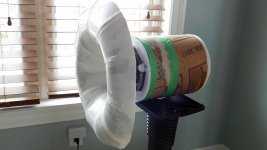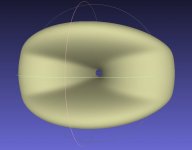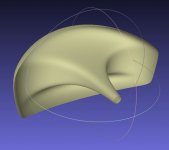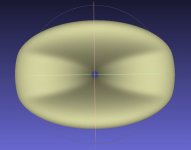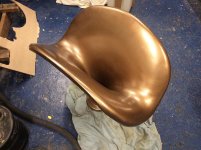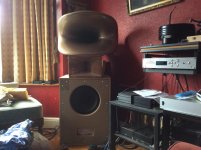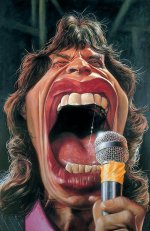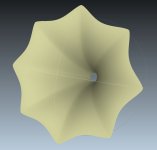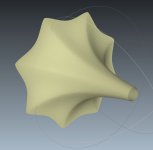With a selective laser sintering (The minimal quality IMHO) this part cost :
5246.47€ white
6482.90€ color
7472.05€ color + laquer
X2 if you need two of them, you must also raise the thickness of the part to be usable, it will increase the cost by a factor of x3 to x10 (you can also buy a lot of things with 140000€).
If i can help...
Try i.materialise.com, I bet it will be cheaper. However it would need an enclosed volume model and not an outline. Even completely closed (capped off top and bottom) still is much cheaper at just over € 1000,00 so printing the real deal would be way cheaper than that, due to less enclosed volume. But it needs a volume model to work. It needs a real thickness to it that exceeds the minimum allowed thickness of the material you want to use or more (if you want a usable product).
What I forgot to mention. The original profile has an intrinsic roll-back. Of course, this can be done also here. The following pictures were calculated until the original maximum outer extension of the profile:
It looks more organic (better) with the full roll back. I can see how that would be very hard to manufacture. Maybe a CNC wood mold and fiberglass mat. You might even find an industrial 3D printer that could make it in sections.
I have seen examples of using a series of contour "ribs" to build a paper mache horn similar to yours. Alternately, the same technique could be used to build a master mold that might due for DIY'ers. Once the profile is built, its easy to smooth and strengthen it.
Try i.materialise.com, I bet it will be cheaper. However it would need an enclosed volume model and not an outline. Even completely closed (capped off top and bottom) still is much cheaper at just over € 1000,00 so printing the real deal would be way cheaper than that, due to less enclosed volume. But it needs a volume model to work. It needs a real thickness to it that exceeds the minimum allowed thickness of the material you want to use or more (if you want a usable product).
I think MeshLab and MeshMixer are able to "bulk up" a surface mesh STL for actual printing.
...You should avoid PLA, it sucks for the planet and the parts made with it are porous junk things.
I'd check your slicer settings, I can print PLA containers that hold water. 😉
Once the big printer I'm building is finished, (300x300x400), I'd be quite happy to do some prototyping if you'd like.
I think MeshLab and MeshMixer are able to "bulk up" a surface mesh STL for actual printing.
In my experience the best method for this is Blenders Solidify modifier. My calculator has already incorporated an material thickness parameter that works together whith "even thickness" in Blender.
3D printing is one option, the approach I used for my latest horns was to cnc machine them in layers from birch ply. I want to try a SEOS type horn next with my JBL 2482’s.
Attachments
3D printing is one option, the approach I used for my latest horns was to cnc machine them in layers from birch ply. I want to try a SEOS type horn next with my JBL 2482’s.
Very nice project! Thanks for sharing. What is the weight of one horn? This looks like the JMLC Iwata horn.
Last edited:
They are 50mm thick ... and weigh about 20 kg each It’s a 2 man lift when the JBL’s are attached. It’s an elliptical JMCL profile.
How do you understand that the distance (Dz) don't correspond at the scale of the graphical representation and how the lines can be curved with some linear coordinates, am i on a ecliptic coordinate system?Patience.
A concave geometric plane? i don't know what there is under my feets?
OMG it's empty space 😀
Paper is 2-3€, why so expensive?€ 1000,00
I will be more than interested by a positive mold for my paper process !I'd be quite happy to do some prototyping if you'd like.
Last edited:
No joke, I've spent around 30 hours this week getting ONE of my 3D printers "dialed in."
Even if my time is worth just $20 per hour, that's $600.
I can totally see why people have their prints made for them, instead of DIY'ing it.
I published an article on how to make horns out of paper about sixteen years ago, but I mostly do 3D prints now because I like asymmetrical horns.
Even if my time is worth just $20 per hour, that's $600.
I can totally see why people have their prints made for them, instead of DIY'ing it.
I published an article on how to make horns out of paper about sixteen years ago, but I mostly do 3D prints now because I like asymmetrical horns.
What do you mean with "dial in"? The hardware calibration or preparation of the STL or printer file?
There are some well known services like sphapeways or all3p but I have no experiences with them. So far as I know the STL file need to be well prepared without any erros.
Another thing seems to be an addition of a support structure. Will this be automatically added by the printer software?
Asymmetry was one of my main motivations either to break symmetry and to favour the hirizontal plane.
There are some well known services like sphapeways or all3p but I have no experiences with them. So far as I know the STL file need to be well prepared without any erros.
Another thing seems to be an addition of a support structure. Will this be automatically added by the printer software?
Asymmetry was one of my main motivations either to break symmetry and to favour the hirizontal plane.
What do you mean with "dial in"? The hardware calibration or preparation of the STL or printer file?
I think the reason that I like audio is because there's a ton of variables to juggle. I'm actually not a huge fan of music, I mostly use my speakers to listen to podcasts and movies. What I like is the *challenge* of audio.
3D printing has a horrendous number of variables. Honestly, it's a bit maddening, it's the kind of hobby that can drive you mad.
Just a short list of variables:
* diameter of the nozzle
* how fast you print
* what you print with
* what temperature you print at
* what temperature is your enclosure
* what do you print ON? (aluminum, glass, tape, kapton, glue, ABS, a combination of the above.)
The biggest variable by far is getting the bed leveled, and that alone is a hobby. Because when you adjust one corner of the bed, it changes the level of everything else 🙁
This week I managed to make THIRTEEN consecutive prints that failed. Number fourteen is printing as we speak, fingers crossed.
I guess Mick's mouth has predominantly emitted white noise since his last golddigger left him.
Speaking of gold, the material of the previously shown 3D printed Tractrix horn is Ice PLA, colour "Glamorous Gold".
It was printed with an 0.8 nozzle and some PVA support.

Speaking of gold, the material of the previously shown 3D printed Tractrix horn is Ice PLA, colour "Glamorous Gold".
It was printed with an 0.8 nozzle and some PVA support.

Last edited:
- Home
- Loudspeakers
- Multi-Way
- Klangfilm spherical wave horn calculator - from round to elliptical
